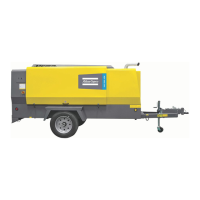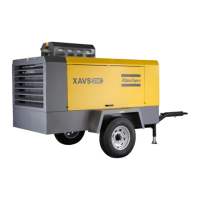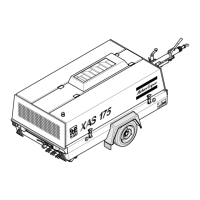- 8 -
GENERAL SAFETY PRECAUTIONS
1 The owner is responsible for maintaining the unit in a
safe operating condition. Unit parts and accessories
must be replaced if missing or unsuitable for safe
operation.
2 The supervisor, or the responsible person, shall at all
times make sure that all instructions regarding
machinery and equipment operation and maintenance
are strictly followed and that the machines with all
accessories and safety devices, as well as the
consuming devices, are in good repair, free of
abnormal wear or abuse, and are not tampered with.
3 Whenever there is an indication or any suspicion that
an internal part of a machine is overheated, the
machine shall be stopped but no inspection covers shall
be opened before sufficient cooling time has elapsed;
this to avoid the risk of spontaneous ignition of oil
vapour when air is admitted.
4 Normal ratings (pressures, temperatures, speeds, etc.)
shall be durably marked.
5 Operate the unit only for the intended purpose and
within its rated limits (pressure, temperature, speeds,
etc.).
6 The machinery and equipment shall be kept clean, i.e.
as free as possible from oil, dust or other deposits.
7 To prevent an increase in working temperature, inspect
and clean heat transfer surfaces (cooler fins,
intercoolers, water jackets, etc.) regularly. See the
Preventive maintenance schedule.
8 All regulating and safety devices shall be maintained
with due care to ensure that they function properly.
They may not be put out of action.
9 Care shall be taken to avoid damage to safety valves
and other pressure-relief devices, especially to avoid
plugging by paint, oil coke or dirt accumulation, which
could interfere with the functioning of the device.
10 Pressure and temperature gauges shall be checked
regularly with regard to their accuracy. They shall be
replaced whenever outside acceptable tolerances.
11 Safety devices shall be tested as described in the
maintenance schedule of the instruction manual to
determine that they are in good operating condition.
See the Preventive maintenance schedule.
12 Mind the markings and information labels on the unit.
13 In the event the safety labels are damaged or destroyed,
they must be replaced to ensure operator safety.
14 Keep the work area neet. Lack of order will increase
the risk of accidents.
15 When working on the unit, wear safety clothing.
Depending on the kind of activities these are: safety
glasses, ear protection, safety helmet (including visor),
safety gloves, protective clothing, safety shoes. Do not
wear the hair long and loose (protect long hair with a
hairnet), or wear loose clothing or jewelry.
16 Take precautions against fire. Handle fuel, oil and anti-
freeze with care because they are inflammable
substances. Do not smoke or approach with naked
flame when handling such substances. Keep a fire-
extinguisher in the vicinity.
SAFETY DURING TRANSPORT AND
INSTALLATION
When towing, lifting or transporting the compressor in
any way, the battery switch must always be in the “OFF”
position!
To lift a unit, all loose or pivoting parts, e.g. doors and
towbar, shall first be securely fastened.
Do not attach cables, chains or ropes directly to the lifting
eye; apply a crane hook or lifting shackle meeting local
safety regulations. Never allow sharp bends in lifting
cables, chains or ropes.
Helicopter lifting is not allowed.
It is strictly forbidden to dwell or stay in the risk zone
under a lifted load. Never lift the unit over people or
residential areas. Lifting acceleration and retardation
shall be kept within safe limits.
1 Before towing the unit:
- ascertain that the pressure vessel(s) is (are) depressurized,
- check the towbar, the brake system and the towing eye.
Also check the coupling of the towing vehicle,
- check the towing and brake capability of the towing
vehicle,
- check that the towbar, jockey wheel or stand leg is safely
locked in the raised position,
- ascertain that the towing eye can swivel freely on the hook,
- check that the wheels are secure and that the tyres are in
good condition and inflated correctly,
- connect the signalisation cable and check all lights
- attach the safety break-away cable or safety chain to the
towing vehicle,
- remove wheel chocks, if applied, and disengage the
parking brake.
2 To tow a unit use a towing vehicle of ample capacity.
Refer to the documentation of the towing vehicle.
3 Never exceed the maximum towing speed of the unit
(mind the local regulations).
4 Place the unit on level ground and apply the parking
brake before disconnecting the unit from the towing
vehicle. Unclip the safety break-away cable or safety
chain. If the unit has no parking brake or jockey wheel,
immobilize the unit by placing chocks in front of and/
or behind the wheels. When the towbar can be
positioned vertically, the locking device must be
applied and kept in good order.

